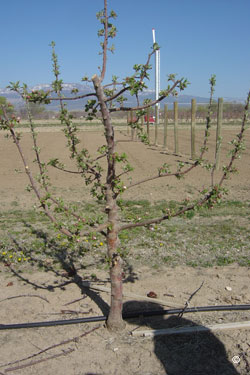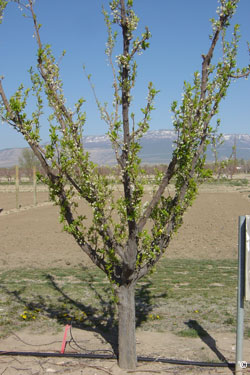
Young fruit trees can be purchased as bare-root whips, or as packaged and container-grown trees. Bare-root whips may have few or no branches. To promote branch development after planting, remove the top of the whip about one-quarter inch above a bud that is roughly 30 to 36 inches above the soil line. If branches are already present, as is usually the case with container-grown trees, remove only dead, broken, or interfering branches until the tree is established. Avoid the temptation to prune the healthy lower branches of the tree right after planting. It’s important to leave as much healthy growth as possible the first year to provide foliage for food production, which is necessary for root establishment.
 In the second year, identify and leave in place branches that are well-spaced up and down the plant. Remove all other branches, particularly when they interfere with each other, grow close to the same point from the trunk, or have acute, upright crotches. These branches are weak and will break under the weight of heavy fruit and snow loads.
In the second year, identify and leave in place branches that are well-spaced up and down the plant. Remove all other branches, particularly when they interfere with each other, grow close to the same point from the trunk, or have acute, upright crotches. These branches are weak and will break under the weight of heavy fruit and snow loads.
In subsequent years, remove weak and interfering branches. It may also be necessary to remove some of the lower branches which were left on the trunk in the first and second years of pruning. The best time to prune is late winter or early spring, just prior to sap production and bud break.
For more information, see the following Colorado State University Extension fact sheet(s).



